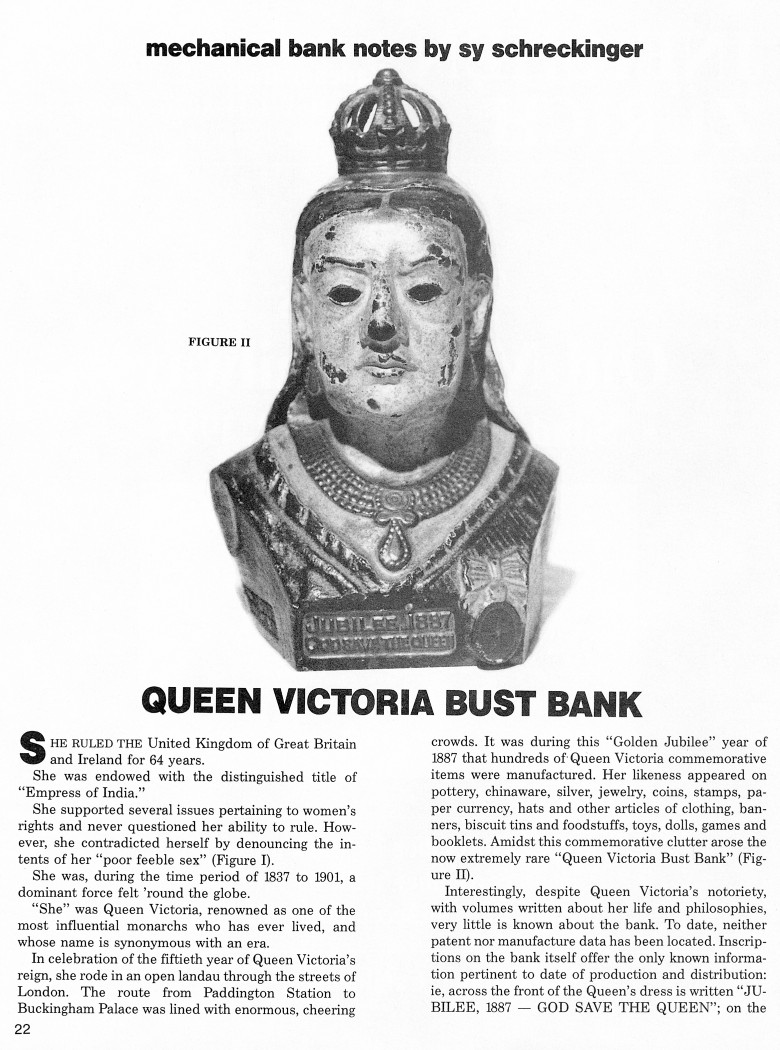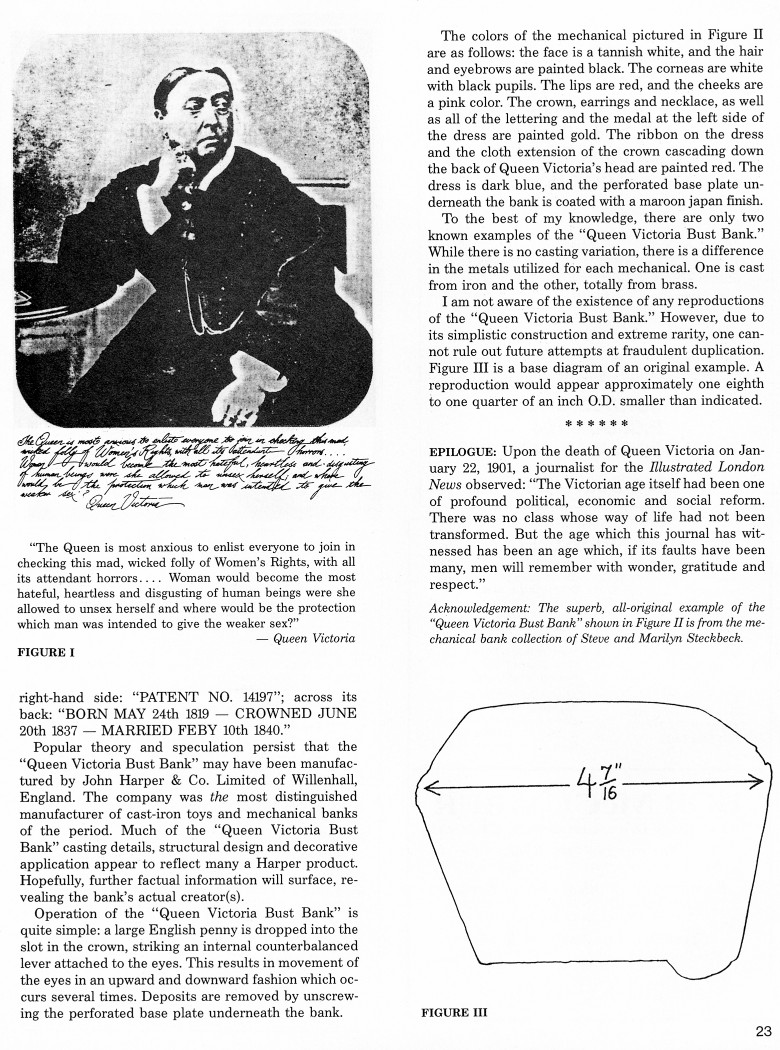|
Queen Victoria Bust Bank
by Sy Schreckinger – ANTIQUE TOY WORLD Magazine – October, 1995
She ruled the United Kingdom of Great Britain
and Ireland for 64 years.
She was endowed with the distinguished title of "Empress of India."
She supported several issues pertaining to women's rights and never
questioned her ability to rule. However, she contradicted herself by
denouncing the intents of her "poor feeble sex" (Figure I).
She was, during the time period of 1837 to 1901, a dominant force
felt 'round the globe.
"She" was Queen Victoria, renowned as one of the most influential
monarchs who has ever lived, and whose name is synonymous with an era.
In celebration of the fiftieth year of Queen Victoria's reign, she
rode in an open landau through the streets of London. The route from
Paddington Station to Buckingham Palace was lined with enormous, cheering
crowds. It was during this "Golden Jubilee" year of 1887 that hundreds of
Queen Victoria commemorative items were manufactured. Her likeness
appeared on pottery, chinaware, silver, jewelry, coins, stamps, paper
currency, hats and other articles of clothing, banners, biscuit tins and
foodstuffs, toys, dolls, games and booklets. Amidst this commemorative
clutter arose the now extremely rare "Queen Victoria Bust Bank" (Figure
II).
Interestingly, despite Queen Victoria's notoriety, with volumes
written about her life and philosophies, very little is known about the
bank. To date, neither patent nor manufacture data has been located.
Inscriptions on the bank itself offer the only known information pertinent
to date of production and distribution: i.e., across the front of the
Queen's dress is written "JUBILEE, 1887 — GOD SAVE THE QUEEN"; on the
right-hand side: "PATENT NO. 14197"; across its back: "BORN MAY 24th 1819
— CROWNED JUNE 20th 1837 — MARRIED FEBY 10th 1840."
Popular theory and speculation persist that the "Queen Victoria Bust
Bank" may have been manufactured by John Harper & Co. Limited of
Willenhall, England. The company was the most distinguished manufacturer
of cast-iron toys and mechanical banks of the period. Much of the "Queen
Victoria Bust Bank" casting details, structural design and decorative
application appear to reflect many a Harper product. Hopefully, further
factual information will surface, revealing the bank's actual creator(s).
Operation of the "Queen Victoria Bust Bank" is quite simple: a large
English penny is dropped into the slot in the crown, striking an internal
counterbalanced lever attached to the eyes. This results in movement of
the eyes in an upward and downward fashion which occurs several times.
Deposits are removed by unscrewing the perforated base plate underneath
the bank.
The colors of the mechanical pictured in Figure II are as follows:
the face is a tannish white, and the hair and eyebrows are painted black.
The corneas are white with black pupils. The lips are red, and the cheeks
are a pink color. The crown, earrings and necklace, as well as all of the
lettering and the medal at the left side of the dress are painted gold.
The ribbon on the dress and the cloth extension of the crown cascading
down the back of Queen Victoria's head are painted red. The dress is dark
blue, and the perforated base plate underneath the bank is coated with a
maroon japan finish.
To the best of my knowledge, there are only two known examples of the
"Queen Victoria Bust Bank." While there is no casting variation, there is
a difference in the metals utilized for each mechanical. One is cast from
iron and the other, totally from brass.
I am not aware of the existence of any reproductions of the "Queen
Victoria Bust Bank." However, due to its simplistic construction and
extreme rarity, one cannot rule out future attempts at fraudulent
duplication. Figure III is a base diagram of an original example. A
reproduction would appear approximately one eighth to one quarter of an
inch O.D. smaller than indicated.
******
"The Queen is most anxious to enlist everyone to join
in checking this mad, wicked folly of Women's Rights, with all its
attendant horrors.... Woman would become the most hateful, heartless and
disgusting of human beings were she allowed to unsex herself and where
would be the protection which man was intended to give the weaker sex?"
— Queen Victoria
******
EPILOGUE: Upon the death of Queen Victoria on January
22, 1901, a journalist for the Illustrated London News observed: "The
Victorian age itself had been one of profound political, economic and
social reform. There was no class whose way of life had not been
transformed. But the age which this journal has witnessed has been an age
which, if its faults have been many, men will remember with wonder,
gratitude and respect."
Acknowledgement: The superb, all-original example of the "Queen
Victoria Bust Bank" shown in Figure II is from the mechanical bank
collection of Steve and Marilyn Steckbeck.
|

